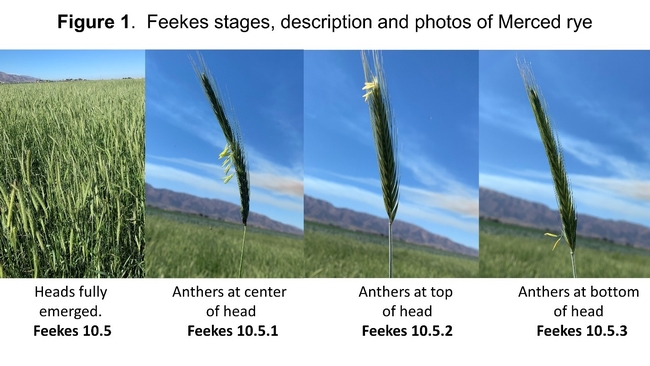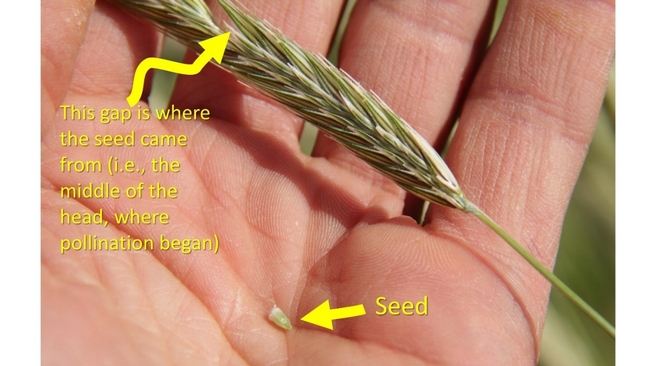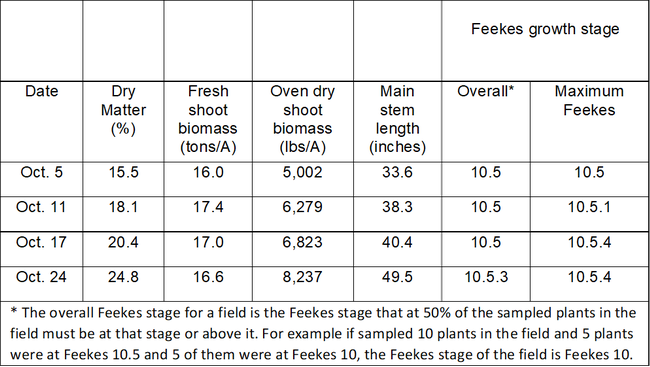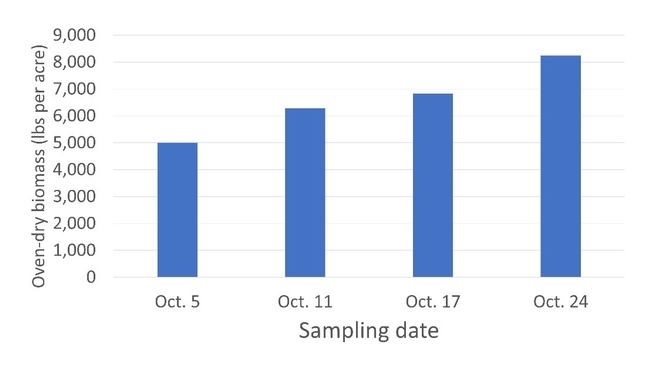Cereal rye, triticale and oats are commonly used as cover crops in the Salinas Valley in fall grown (Aug/Sept to Oct/Nov) and overwintered (Oct/Nov to Feb/March) planting slots. A key issue for growers is when to terminate the cover crop. This boils down to availability of equipment or breaks in the weather. Those types of issues are unavoidable and usually take precedence in decision making. In this article, we describe the various stages of cover crop seed development so that growers can let their cereal cover crop grow as long as possible without the risk of it producing seed that would become a weed in subsequent vegetable crops. This will allow the carbon to nitrogen (C:N) ratio to increase as high as possible to maximize the input of carbon to the soil to benefit soil health and potentially suppress soilborne diseases.
In the central coast region, there is often confusion and concern about when the cover crop will set seed. However, the presence of heads in the cover crop does not mean that seed set is about to happen. Seed formation in cereals follows the relatively lengthy process of pollination and seed development as laid out in the Feekes growth and development chart (Table 1; for a complete chart go to: Kansas State University or University of Wisconsin). Flowering occurs in Feekes stages 10.5.1 to 10.5.3 beginning in the center of the head (Figure 1). During these stages the cover crop is not setting seed but is pollinating. After pollination, the next Feekes stage is 10.5.4 which is when the seed is in the ‘watery ripe' stage (Figure 2). To avoid the risk of viable seed set, we recommend that growers not let their cover crops get past the 10.5.4 Feekes stage. In other words, it is best not to let the seed become milky (11.1) or mealy (soft dough) (11.2) ripe.
The amount of time from full heading through the stages of flowering shown in Figure 1 can vary based on temperature, time of year (day length) and variety. For example, in an over-winter trial planted October 1, 2021 at the USDA-ARS at organic research farm in Salinas, a UC696 barley cover crop reached the soft dough stage (11.2) at 122 days after planting whereas by that time, Pacheco triticale and Merced rye were still only at the water ripe stage (10.5.4); by 150 days after planting the barley was at Feekes 11.3 (hard dough) while rye and triticale were at 11.1 (milky ripe stage). This is why barley is not often used as a cover crop in the region because it has greater potential to set seed than later maturing types of cereals like rye and triticale. However, seed set by cover crops like Merced rye is extremely uncommon here. For example, in a long term organic cover crop study with intensive vegetable production at the USDA-ARS in Salinas, there were never any problems with viable seed production by Merced rye cover crops planted from October 15 to November 2 and terminated from February 11 to March 18. Over 8 years the average oven-dry shoot biomass production in that trial was more than 6000 lb per acre and the C:N was 29 (Brennan and Boyd, 2012; Brennan, Boyd and Smith 2013). Unfortunately, in that trial we did not collect data on the Feekes growth stages of the rye. However, data from our planting date trials this past winter at the same location indicates that overwintered Merced rye planted even early as October 1 needs more that 120 days of growth to develop past the Feekes 10.5.4 stage (watery ripe). The development of Merced rye planted October 15 to November 30 was even more delayed and had not even started to flower by 119 to 122 days after planting.
This all indicates that for an overwintered Merced rye cover crop, there is very little risk of viable seed set before 120 days of growth even for rye planted as early as October 1 when the days are still relatively long and warm. Our data thus far suggests that it takes approximately 1000 degree days (°C) to reach the 10.5.4 growth stage; this assumes a 4 °C based threshold and single sine/horizontal method calculated on the UCIPM degree day calculator available here. To put this in context, for a summer/fall cover crop planted on August 1 this year, 1000-degree days were reached by October 13 (74 days after planting) based on this weather station (NCDC #7669, Salinas FAA Airport). In contrast, if that cover crop had been planted on October 1, 2021, it would reach 1000 degree days by January 24, 2022 (115 days after planting). Thus, growers can use the degree calculator and historic data to estimate degree day accumulation for cover crops planted at various times of year.
The simplest way to determine how close the cover crop is to forming viable seed is to examine the cover crop to see if fresh yellow anthers are present (older anthers may hang onto the head, but will often bleach to a dull, white color) and where they are occurring on the head (Figure 1). Anthers are visible regardless of the type of cereal crop, but in our experience, they are more apparent in crops like rye than in other cereals. It should be noted that anthers may be present/visible after the crop has moved beyond anthesis. To confirm if the seed is getting close to maturing, it is best to examine the seed in the heads to see if they are maturing past the watery ripe stage (Figure 2), particularly if the crop has not been frequently monitored and/or the onset of anthesis is unknown. Given favorable weather and available equipment, this information can help provide context about the risk of seed set and help you decide whether to allow the cover crop to continue to grow and thereby increase the C:N ratio. Learning to identify the Feekes growth stages of a cover crop will not only help growers become more knowledgeable about when a cover crop needs to be terminated to avoid setting viable seed. It will also help growers get a higher cover crop nitrogen scavenging credit as part of Ag Order 4.0 as described in this recent video.
Table 1 has an evaluation that we just completed of a fall-grown cover crop in a grower's field in Gonzales, CA over a three-week period. As can be seen, the biomass production and C:N ratio of the cover crop increased each week that the cover crop was allowed to continue growing (Table 1, Figure 3). By October 24th many seed in the heads of the cover crop were at the watery ripe stage and it was judged that it was time to terminate the cover crop to avoid the risk of setting viable seed.
Table 1. Merced rye late summer/fall cover crop evaluation conducted in 2022 evaluating the impact of allowing the cover crop to continue to grow. The cover crop was planted Aug. 18 in Gonzales. These values are based on data from 10 samples in the field on each harvest date.
Caveats and cautions:
Merced rye, like other cereal rye varieties (i.e., FL104) is an out-crossing variety that tends to be more variable in its development than other small grains like triticale that are self-pollinated and more uniform. This is important keep in mind when evaluating the growth stage of a field. However, with all cereal cover crops it is important to look at the most advanced part of the field (i.e., where irrigation occurred first) and the most developed plants and make your decision about how to manage the field from them. When checking grain stages, be aware that different kernels from the same head can vary in developmental stage. Therefore, checking multiple kernels to determine the status of the head is advisable.



